2. 中国科学院地质与地球物理研究所, 岩石圈演化国家重点实验室, 北京 100029
2. State Key Laboratory of Lithospheric Evolution, Institute of Geology and Geophysics, Chinese Academy of Sciences, Beijing 100029, China
虽然钙硅酸盐成分的岩石在麻粒岩地体中很少,但是它所含的矿物组合以及反应结构可以很好地指示变质PT条件和流体活动(Motoyoshi et al., 1991; Fitzsimons and Thost, 1992; Harley and Buick, 1992; Dasgupta, 1993; Fitzsimons and Harley, 1994; Harley et al., 1994; Satish-Kumar et al., 1996; Stephenson and Cook, 1997; Sengupta et al., 1997; Satish-Kumar and Harley, 1998; Mathavan and Fernando, 2001; Sengupta and Raith, 2002; Groppo et al., 2013; Thu and Enami, 2018)。方柱石是一种在钙硅酸盐岩中常见的富含挥发性组分的架状硅酸盐矿物,成分变化范围大,且可以提供关于变质时期流体的组分信息(Mora and Valley, 1989; Kullerud and Erambert, 1999; Satish-Kumar et al., 2006),其拥有两个固溶体端元,分别是钠柱石(Na4Al3Si9O24Cl)和钙柱石(Ca4Al6Si6O24CO3)(Teertstra and Sherriff, 1997)。钙柱石是下地壳的一种重要碳酸盐储备(Moecher et al., 1994),而钠柱石则富集卤族元素,其被认为形成于蒸发岩或者与高浓度含盐流体有关(Oliver et al., 1994; Kullerud and Erambert, 1999; Deer et al., 2013)。与其它含氯元素矿物不同的是(例如磷灰石、角闪石和云母),方柱石几乎不含羟基。方柱石是一种水热、变质、或者交代成因的矿物,通常是由斜长石与富Cl或CO2的流体反应生成(Goldsmith, 1976; Mora and Valley, 1989; Rebbert and Rice, 1997),也可通过大理岩的交代和变质作用形成(Markl and Piazolo, 1998; Guo et al., 2016)。前人研究的钙硅酸盐岩主要分布于印度的Eastern Ghats和Kerala孔兹岩带、斯里兰卡Maligawila地区、澳大利亚中部Arunta块体和东南极的Rauer群与Northern Prince Charles Mountains,这些钙硅酸盐岩均分布于元古代时期的麻粒岩地体中,太古代时期的钙硅酸盐岩鲜有报道,并且这些麻粒岩地体中的钙硅酸盐岩峰期矿物常以出现硅灰石+方柱石为特征,钙铝榴石-钙铁榴石系列的石榴子石+单斜辉石常作为贯通矿物,钙铝榴石常以冠状体形式出现(Warren et al., 1987; Harley and Buick, 1992; Buick et al., 1993; Dasgupta, 1993; Fitzsimons and Harley, 1994; Bhowmik et al., 1995; Sengupta et al., 1997; Stephenson and Cook, 1997; Satish-Kumar and Harley, 1998; Mathavan and Fernando, 2001; Sengupta and Raith, 2002; Dasgupta and Pal, 2005)。
本研究对来自印度南部麻粒岩地体Namakkal陆块Tammampatti地区钙硅酸盐岩进行详细的岩石学观察,发现其矿物组合以方柱石+石榴子石+斜长石+榍石+钛铁矿为特征,而前人对该矿物组合稳定的温压范围缺乏有效限定,此外,它们的岩石成因和地质意义也不清楚。因此,我们在详细的岩相学观察基础上,通过Na2O-CaO-FeO-MgO-Al2O3-SiO2-TiO2-Fe2O3-CO2-H2O体系相平衡模拟和LA-ICP-MS锆石U-Pb定年,限定了这些钙硅酸盐岩的变质温压条件与时代,用以揭示它们的岩石学成因和地质意义。
1 区域地质背景印度半岛南部由太古代达瓦克拉通(DC)和南部麻粒岩地体组成(图 1; Brandt et al., 2014)。根据西部绿岩带的分布范围以及东部年轻的花岗质侵入体,通常将达瓦克拉通划分为西达瓦克拉通(WDC)与东达瓦克拉通(EDC)(Chadwick et al., 2000; Jayananda et al., 2000; Hokada et al., 2013)。最近有学者在东西达瓦克拉通之间进一步划分出了中达瓦克拉通(CDC) (Peucat et al., 2013; Jayananda et al., 2018; Wang and Santosh, 2019)。
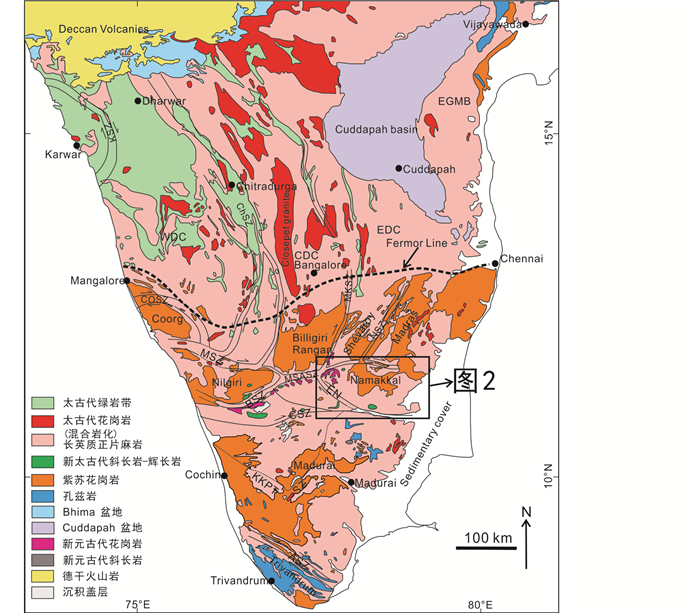
|
图 1 印度南部区域地质图(据Ishwar-Kumar et al., 2013; Plavsa et al., 201; Lancaster et al., 2015; He et al., 2020修改) KSZ-Kumta剪切带;COSZ-Coorg剪切带;ChSZ-Chitradurga剪切带;MKSZ-Mettur-Kolar剪切带;NSZ-Nallamalai剪切带;MSZ-Moyar剪切带;MSASZ-Moyar-Salem-Attur剪切带;EN-Erode-Namakkal剪切带;BSZ-Bhavani剪切带;CSZ-Cauvery剪切带;KKPTSZ-Karur Kambam Painavu Trichur剪切带;ASZ-Achankovil剪切带;WDC-西达瓦克拉通;CDC-中达瓦克拉通;EDC-东达瓦克拉通;EGMB-Eastern Ghats活动带 Fig. 1 Map showing geo-tectonic framework of southern India (modified after Ishwar-Kumar et al., 2013; Plavsa et al., 2014; Lancaster et al., 2015; He et al., 2020) KSZ-Kumta shear zone; COSZ-Coorg shear zone; ChSZ-Chitradurga shear zone; MKSZ-Mettur-Kolar shear zone; NSZ-Nallamalai shear zone; MSZ-Moyar shear zone; MSASZ-Moyar-Salem-Attur shear zone; EN-Erode-Namakkal shear zone; BSZ-Bhavani shear zone; CSZ-Cauvery shear zone; KKPTSZ-Karur Kambam Painavu Trichur shear zone; ASZ-Achankovil shear zone; WDC-Western Dharwar craton; CDC-Central Dharwar craton; EDC-Eastern Dharwar craton; EGMB-Eastern Ghats mobile belt |
西达瓦克拉通主要由~3.3Ga TTG片麻岩和绿岩带(Peucat et al., 1995; Jayananda et al., 2008),ca. 2.7~2.6Ga的Dharwar群(Nutman et al., 1996; Trendall et al., 1997a, b; Jayananda et al., 2013b),以及2.61Ga的钾质花岗岩(Jayananda et al., 2006)组成。中达瓦克拉通发育有大量超过3.0Ga的TTG片麻岩与少量~2.7Ga的绿岩带(Jayananda et al., 2000, 2013b; Chardon et al., 2011),以及~2.52~2.51Ga Closepet花岗岩(Friend and Nutman, 1991; Jayananda et al., 1995, 2000; Moyen et al., 2003; Peng et al., 2019)。东达瓦克拉通发育有ca. 2.7~2.6Ga英云闪长质片麻岩,~2.7Ga的绿岩带,以及ca. 2.55~2.53Ga的长英质岩浆岩(Peucat et al., 2013; Glorie et al., 2014; Jayananda et al., 2013a, 2018)。
达瓦克拉通的南部由几个紫苏花岗岩微陆块围绕,自西向东依次为Coorg、Nilgiri、Billigiri Rangan、Shevaroy、Madras和Namakkal陆块(图 1)。前人研究认为这些微陆块在新太古代-古元古代早期沿着不同的缝合带聚合在一起(Li et al., 2018)。然而,达瓦克拉通西南方向的Coorg陆块,由于缺乏在其它紫苏花岗岩微陆块广泛发育的~2.5Ga区域变质作用记录,推测其很可能是一个外来的中太古代陆块(Santosh et al., 2015)。
Nilgiri陆块主要由紫苏花岗岩、基性麻粒岩、角闪石-黑云母片麻岩、变沉积岩、辉石岩、角闪岩和条带状含铁建造组成(Raith et al., 1999; Samuel et al., 2014, 2015, 2016, 2018)。紫苏花岗岩原岩结晶年龄为2676±13Ma和2560±7Ma(Peucat et al., 2013),变质年龄在2.52~2.45Ma之间变化(Peucat et al., 2013; Samuel et al., 2014)。基性麻粒岩的岩浆结晶年龄为2539±3Ma,变质年龄为2459±9Ma,其记录了一个逆时针的P-T轨迹,峰期变质条件为ca. 850~900℃/ca. 14~15kbar(Samuel et al., 2015)。石榴子石辉石岩的岩浆结晶年龄为2532±22Ma,变质时代为2520±27Ma和2478±27Ma,同样记录了逆时针的P-T轨迹,峰期变质达到ca. 900~1000℃/ca. 18~20kbar(Samuel et al., 2018)。
Billigiri Rangan陆块主要由紫苏花岗岩、基性麻粒岩、花岗岩、长英质片麻岩、角闪岩、混合岩和变花岗岩组成(Peucat et al., 2013; Ratheesh-Kumar et al., 2016, 2020)。锆石U-Pb定年结果显示紫苏花岗岩的原岩结晶年龄为3.36Ga、2.60Ga和2.55~2.54Ga(Peucat et al., 2013; Ratheesh-Kumar et al., 2020),变质年龄从2.53Ga到2.50Ga之间变化(Peucat et al., 2013; Ratheesh-Kumar et al., 2016, 2020),而基性麻粒岩记录的变质年龄为~2.55Ga(Ratheesh-Kumar et al., 2020)。
Shevaroy陆块主要由紫苏花岗岩、长英质片麻岩和碱性杂岩组成(Peucat et al., 2013; Glorie et al., 2014; Li et al., 2018)。紫苏花岗岩原岩年龄为2.76Ga和~2.55Ga,变质年龄为~2.52Ga,长英质片麻岩原岩年龄为2.90~2.63Ga和~2.55Ga,变质年龄为2.53~2.50Ga(Peucat et al., 2013; Glorie et al., 2014)。碱性杂岩的岩浆结晶时代为820~800Ma(Glorie et al., 2014)。Madras陆块主要由紫苏花岗岩、混合岩、花岗闪长岩、长英质片麻岩、角闪岩以及条带状含铁建造组成(Li et al., 2018)。现有年代学数据显示这些岩石的岩浆结晶年龄为2.58~2.50Ga,变质时代为2.54~2.46Ga(Crawford, 1969; Bernard-Griffiths et al., 1987; Li et al., 2018)。
Namakkal陆块北部以Salem Attur剪切带(SASZ)为界,主要由长英质片麻岩、基性麻粒岩与变沉积岩组成(Anderson et al., 2012; Noack et al., 2013; Saitoh et al., 2011; Sato et al., 2011a)。长英质片麻岩的地质年代学研究表明其原岩结晶年龄为2.65Ga、2.60Ga和2.54~2.53Ga,于2.49~2.44Ga发生变质作用(Anderson et al., 2012; Noack et al., 2013; Saitoh et al., 2011; Sato et al., 2011a)。Noack et al. (2013)利用全岩Lu-Hf限定基性麻粒岩原岩年龄为2536±300Ma,峰期变质年龄为2434±17Ma (石榴子石Lu-Hf测年)。该地区的含蓝晶石-石榴子石的长英质片麻岩记录的峰期温压条件为820~860℃/14~16kbar,变质时代为2490~2470Ma(Anderson et al., 2012)。此外,Santosh et al. (2014)在该地区报道了大约800Ma的碱性岩浆侵入时代。
Namakkal陆块中部主要由紫苏花岗岩、长英质片麻岩、角闪石黑云母片麻岩、花岗岩、辉石岩、基性-超基性杂岩体以及少量的条带状磁铁石英岩组成(Clark et al., 2009; Mohan et al., 2013; Glorie et al., 2014; Behera et al., 2019; Peng et al., 2019; George et al., 2019; Talukdar et al., 2020)。锆石U-Pb定年显示紫苏花岗岩原岩结晶年龄为2580~2530Ma,变质时代为2520~2480Ma(Clark et al., 2009; Glorie et al., 2014; Behera et al., 2019; Peng et al., 2019)。此外,前人对位于Namakkal地区的Sittampundi层状基性杂岩体进行了研究(Sajeev et al., 2009; Mohan et al., 2013),Sajeev et al. (2009)认为出现于斜长岩中的退变榴辉岩变质条件为1020℃/20kbar。锆石U-Pb定年得到斜长岩的原岩结晶年龄为2541±13Ma,变质年龄为2461±14Ma(Mohan et al., 2013),而He et al. (2021)得到斜长岩的原岩结晶年龄为2522±12Ma。George et al. (2019)对Jambumalai地区的石榴子石辉石岩进行研究,得到其变质年龄为2526±38Ma,峰期变质条件为22kbar/980℃。
Namakkal陆块南部以Cauvery剪切带(CSZ)为界,主要由太古代的角闪石片麻岩组成,其中有年轻花岗岩体的侵入,锆石U-Pb定年显示这些花岗岩结晶年龄为~560Ma(Brandt et al., 2014; Plavsa et al., 2015; Glorie et al., 2014)。该区域也分布有含假蓝宝石的超高温麻粒岩(Santosh et al., 2004, 2006; Shimpo et al., 2006; Collins et al., 2007; Nishimiya et al., 2010)。CSZ边缘的Devannur-Mahadevi地区,Yellappa et al. (2012)对奥长花岗岩进行锆石U-Pb定年,得到奥长花岗岩的结晶年龄分别为2528±61Ma和2545±56Ma。Talukdar et al. (2020)对该地区的长英质片麻岩进行锆石U-Pb定年,得到原岩年龄大于2530Ma, 变质年龄为2479±4Ma。在Manamedu地区,Sato et al. (2011b)对斜长花岗岩进行锆石U-Pb定年,得到817±16Ma的岩浆结晶年龄,而Santosh et al. (2012)对该地区的斜长花岗岩与变辉长岩进行研究,分别得出782±24Ma~737±23Ma和786±7Ma~744±11Ma的岩浆结晶年龄,其被认为是冈瓦纳超大陆聚合(~550Ma)之前莫桑比克洋洋壳的残留(Santosh et al., 2009)。
2 分析方法本次研究中,除了锆石的分选和阴极发光照相(CL)在广州拓岩检测技术有限公司进行外,其它的分析测试均在西北大学大陆动力学国家重点实验室完成。
LA-ICP-MS锆石U-Pb定年分析条件:激光频率为6Hz,束斑直径为32μm。实验中采用He作为剥蚀物质的载气,使用美国国家标准技术研究院研制的人工合成硅酸盐玻璃标准参考物质NIST SRM 610进行仪器最佳化,每完成6个测点的样品测定,加测标样一次。锆石年龄采用国际标准锆石91500作为外标标准物质,元素含量采用NIST SRM 610作为外标,29Si作为内标。同位素比值与微量元素含量通过GLITTER软件进行处理。
全岩主量元素分析步骤如下:先将样品粉碎到200目,然后称取样品0.7±0.0001g,加入Li2B4O7 5.2±0.001g、助熔剂及脱模剂的LiF 0.4±0.001g,氧化剂NH4NO3 0.3±0.001g,将四者混和均匀后,放入铂金锅中,再加滴1~2滴脱模剂溴化锂。在1200℃下加热8分钟,至冷却后将玻璃熔片从锅中取出,将玻璃熔片放入荧光光谱仪(XRF)自动进样系统进行测试。
矿物化学分析测试仪器型号为JEOL JXA-8230,分析条件为加速电压15kV,电流10nA,分析束斑因测试矿物而异,方柱石采用10μm,其余矿物均采用2μm。不同元素采用SPI公司提供的不同矿物标样进行校正,石英/硬玉-Si,硬玉/斜长石-Al,硬玉/钠长石-Na,透辉石-Ca,橄榄石-Mg,透长石-K,钛铁矿-Fe,蔷薇辉石-Mn,金红石-Ti。本文中矿物缩写符号均采用Whitney and Evans (2010)。部分矿物缩写如下:Grt:石榴子石;Ep:绿帘石;Pl:斜长石;Scp:方柱石;Cal:方解石;Kfs:钾长石;Qz: 石英;Spn:榍石;Ilm:钛铁矿。
3 岩相学与矿物化学本次研究的钙硅酸盐岩样品来自南部麻粒岩地体Namakkal陆块Tammampatti地区东南方向约18km的紫苏花岗岩地体(11°17′16.2″N、78°32′09.1″E)(图 2),该钙硅酸盐岩取自农田附近的采石堆中(图 3a),野外产状并不清楚,手标本呈灰黑色,块状构造,与紫苏花岗岩的接触边界清晰(图 3b)。在详细岩石学观察和全岩化学成分分析的基础上,本研究选择18ID-24和18ID-25两个样品进行研究。这2个样品的岩石学特征与全岩主量元素成分存在细微差异,为了更准确限定它们的变质温压条件,我们对它们同时进行了岩石学和相平衡模拟计算研究,起到相互补充印证的作用。详细的岩石学和矿物化学介绍如下。

|
图 2 南部麻粒岩地体Namakkal陆块地质图(据George and Sajeev, 2015; George et al., 2019修改) Fig. 2 Geological map of the Namakkal Block of the Southern Granulite Terrain (modified after George and Sajeev, 2015; George et al., 2019) |

|
图 3 Tammampatti地区方柱石石榴子石钙硅酸盐岩野外照片 (a)农田附近的采石堆;(b)方柱石石榴子石钙硅酸盐岩与紫苏花岗岩接触关系 Fig. 3 Field photographs of the scapolite-garnet calc-silicate in the Tammampatti area (a) the quarry near the farmland; (b) the boundary between the scapolite-garnet calc-silicate and charnockite |
该样品具有花岗变晶结构,块状构造,主要矿物有方柱石(10%)、石榴子石(30%)、斜长石(50%)、方解石(5%)、绿帘石(4%)和石英(1%),副矿物有锆石、榍石、钛铁矿、磷灰石(图 4a~c)。方解石,斜长石与石英以冠状体的形式出现在方柱石的边缘(图 4b),可能为方柱石分解的产物。绿帘石出现在石榴子石颗粒边缘(图 4c)。石榴子石为钙铝榴石-钙铁榴石-铁铝榴石固溶体,几乎不含锰铝榴石和镁铝榴石(Grs=0.620~0.635; Adr=0.164~0.175; Alm=0.192~0.203; Prp=0.004~0.006; Sps=0.002~0.003)(表 1)。石榴子石从核部到边部,除了钙铁榴石含量有轻微升高,钙铝榴石有轻微降低趋势外,其余组分端元没有明显变化(图 5)。斜长石主要为钙长石端元(XAn=0.988~0.992; XAb=0.007~0.011; XOr=0.000~0.001)(表 1)。方柱石主要为钙柱石端元(EqAn=89.700~92.135;Me%=95.450~95.700)(表 1)。
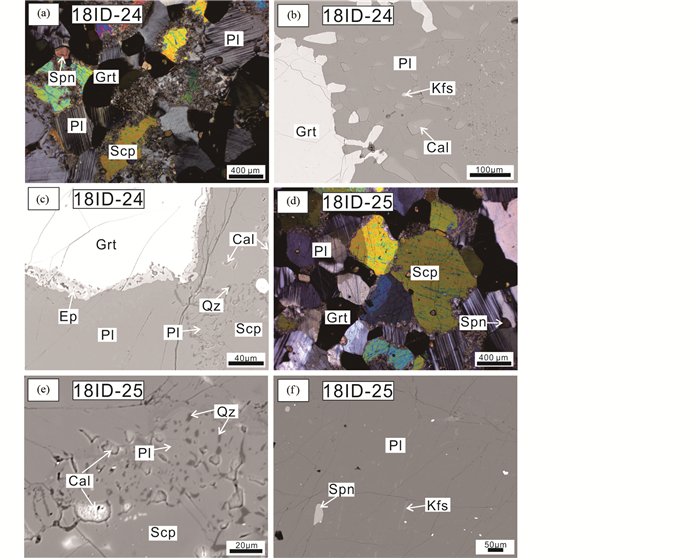
|
图 4 Tammampatti地区方柱石石榴子石钙硅酸盐岩显微照片 样品18ID-24的花岗变晶结构和矿物组合(a, 正交偏光)、方柱石周围的方解石、斜长石以及石英后成合晶(b, 背散射图像)及石榴子石边缘的绿帘石冠状体(c, 背散射图像);样品18ID-25的花岗变晶结构和矿物组合(d, 正交偏光)、方柱石周围的方解石、斜长石以及石英冠状体(e, 背散射图像)及斜长石中出溶钾长石(f, 背散射图像) Fig. 4 Photo-micrographs of the scapolite-garnet calc-silicate in the Tammampatti area Granoblastic texture and mineral assemblages (a, cross-polarized light), calcite and plagioclase surrounding scapolite (b, BSE image) and epidote corona between garnet and plagioclase (c, BSE image) in the Sample 18ID-24;Granoblastic texture and mineral assemblages (d, cross-polarized light), symplectite of calcite, plagioclase and quartz surrounding scapolite (e, BSE image) and K-feldspar exsolution in plagioclase (f, BSE image) in the Sample 18ID-25 |
|
|
表 1 方柱石石榴子石钙硅酸盐岩(样品18ID-24)矿物成分(wt%) Table 1 Representative mineral compositions from the scapolite-garnet calc-silicate (Sample 18ID-24) (wt%) |
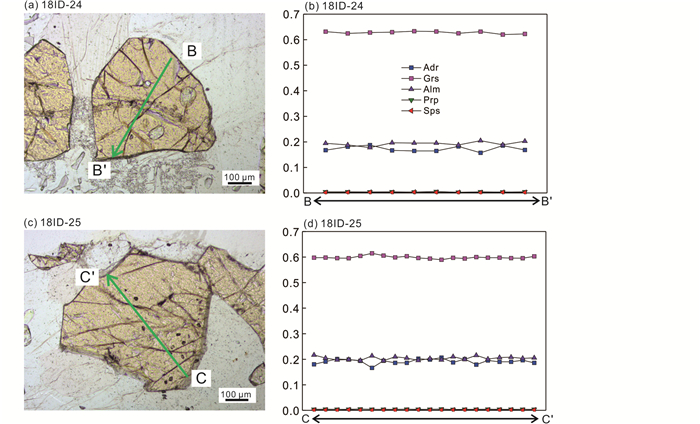
|
图 5 方柱石石榴子石钙硅酸盐岩中石榴子石的成分剖面 Adr-钙铁榴石;Grs-钙铝榴石;Alm-铁铝榴石;Prp-镁铝榴石;Sps-锰铝榴石 Fig. 5 Compositional profiles of the garnets of the scapolite-garnet calc-silicate samples Adr-andradite; Grs-grossular; Alm-almandine; Prp-pyrope; Sps-spessartine |
该样品同样具有花岗变晶结构,块状构造,主要矿物有方柱石(10%)、石榴子石(36%)、斜长石(46%)、方解石(4%)、绿帘石(4%)、以及石英(1%);副矿物有锆石、榍石、钛铁矿、磷灰石(图 4d-f)。方解石,斜长石与石英以后成合晶的形式出现在方柱石的边缘(图 4e)。石榴石为钙铝榴石-钙铁榴石-铁铝榴石固溶体,几乎不含锰铝榴石和镁铝榴石(Grs=0.590~0.605; Adr=0.185~0.210; Alm=0.195~0.210; Prp=0.003~0.005; Sps=0.001~0.003)(表 2)。石榴子石成分比较均一,自核部到边部,除了钙铁榴石稍有降低,铁铝榴石稍有升高外,其余端元组分没有明显变化(图 5)。斜长石主要为钙长石端元(XAn=0.975~0.985; XAb=0.017~0.025; XOr=0.000~0.001)(表 2)。方柱石成分较为均一,主要为钙柱石端元(EqAn=85.830~88.000; Me%=93.350~94.321)(表 2)。
|
|
表 2 方柱石石榴子石钙硅酸盐岩(样品18ID-25)矿物化学成分(wt%) Table 2 Representative mineral compositions of the scapolite-garnet calc-silicate (Sample 18ID-25) (wt%) |
综合2个样品在镜下观察到的矿物反应结构,可以得出本研究中方柱石石榴子石钙硅酸盐岩的峰期变质矿物组合为石榴子石+方柱石+斜长石+榍石+钛铁矿。绿帘石环绕石榴子石颗粒边部生长,方解石、斜长石与石英则出现方柱石的边缘,指示它们是在峰期变质作用之后形成。
4 锆石U-Pb年代学 4.1 锆石结构与定年结果本研究的方柱石石榴子石钙硅酸盐岩中锆石颗粒较大,粒径为100~300μm,阴极发光(CL)显示部分锆石具有核边结构,核部表现为高亮度,弱分带或无分带现象,为典型的变质锆石,边部为发光较暗的变质边。此外可见单颗粒的高亮度或低亮度锆石,高亮度锆石发光均匀,弱分带或无分带现象,为变质成因锆石;低亮度锆石显示补丁状、冷杉树状结构,为典型的变质锆石(图 6)。在年龄谐和图中,高亮度变质锆石测点(32个测点)年龄整体上比低亮度变质锆石(17个测点)要老一些(表 3)。除去3个信号异常测点(12、13和49)(图 7a),分别对剩余的高亮度和低亮度锆石较为谐和测点年龄进行加权平均,得到高亮度变质锆石的207Pb/206Pb加权平均年龄为2562±17Ma,而低亮度变质锆石207Pb/206Pb加权平均为2495±15Ma(图 7b, c)。
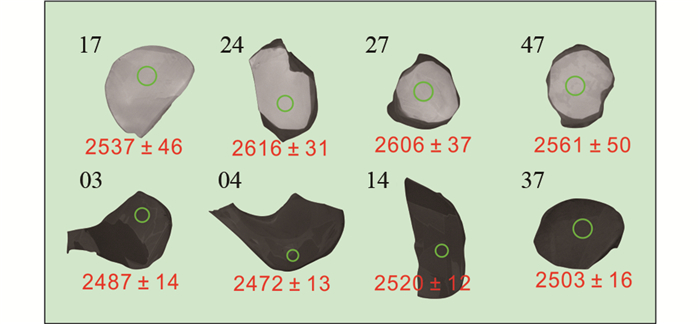
|
图 6 Tammampatti地区方柱石石榴子石钙硅酸盐岩(样品18ID-24)代表性锆石颗粒阴极发光图像、测试点位和对应表面年龄(Ma) Fig. 6 Representative zircon cathodoluminescence (CL) images with analytical spots of the scapolite-garnet calc-silicate (Sample 18ID-24) from the Tammampatti area |
|
|
表 3 方柱石石榴子石钙硅酸盐岩(样品18ID-24)锆石U-Pb同位素数据及年龄 Table 3 LA-ICP-MS U-Pb isotopic age data of the scapolite-garnet calc-silicate (Sample 18ID-24) |
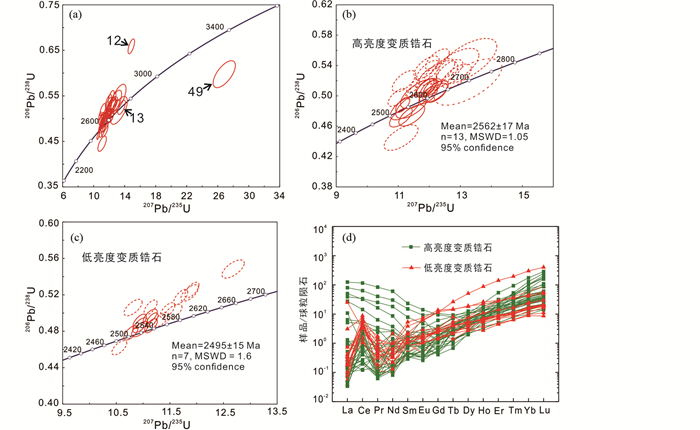
|
图 7 Tammampatti地区方柱石石榴子石钙硅酸盐岩锆石U-Pb年龄谐和图和锆石球粒陨石标准化稀土元素配分曲线图 (a)方柱石石榴子石钙硅酸盐岩所有分析的变质锆石U-Pb年龄谐和图;(b)高亮度变质锆石U-Pb年龄谐和图;(c)低亮度变质锆石U-Pb年龄谐和图;(d)两种变质锆石的球粒陨石标准化稀土元素配分图(标准化值引自Sun and McDonough, 1989) Fig. 7 Concordia diagram and the chondrite-normalized REE patterns for zircon of scapolite-garnet calc-silicate in the Tammampatti area (a) concordia diagram for all analyzed metamorphic zircons of the scapolite-garnet calc-silicate; (b) concordia diagram for metamorphic zircons with high luminescence; (c) concordia diagram for metamorphic zircons with low luminescence; (d) the chondrite-normalized REE patterns for two metamorphic zircons from the scapolite-garnet calc-silicate (normalization values from Sun and McDonough, 1989) |
本次研究共进行了49个锆石微区微量元素测试,所得结果见表 4和图 7d。高亮度变质锆石稀土元素总量为4.8×10-6~152.6×10-6,Th/U为0.02~0.65,(Gd/Yb)N比值在0.01~0.39之间,球粒陨石标准化稀土配分图显示轻稀土变化范围较大,Eu的负异常不明显,Eu/Eu*比值为0.46~4.27。低亮度变质锆石稀土元素总量为7.2×10-6~112×10-6,Th/U为0.06~0.24,(Gd/Yb)N比值在0.04~0.30之间,在球粒陨石标准化稀土配分图中显示较低的轻稀土配分模式,Eu/Eu*比值在0.55~1.25,两种锆石的重稀土配分样式相似。
|
|
表 4 方柱石石榴子石钙硅酸盐岩(样品18ID-24)锆石微量元素含量表(×10-6) Table 4 LA-ICP-MS trace element compositions (×10-6) of zircon from the scapolite-garnet calc-silicate (Sample 18ID-24) |
本文选用Perple_X 6.9.0(Connolly, 1990, 2005) 热力学软件,对方柱石石榴子石钙硅酸盐岩样品18ID-24和18ID-25分别进行了相平衡模拟。全岩主量成分见表 5,其中FeO含量使用滴定法确定。钙硅酸盐岩样品中MnO和K2O成分含量很低,在模拟中忽略这些组分,因此在复杂体系NCFMASTO-CO2-H2O(Na2O-CaO-FeO-MgO-Al2O3-SiO2-TiO2-Fe2O3-CO2-H2O)下进行计算,计算相图的成分如表 5所示。数据库选用hp62ver. dat (Holland and Powell, 1998, 2011),流体状态方程采用Holland and Powell (1998)。采用的矿物活度模型如下:石榴子石和钛铁矿为White et al. (2000),斜长石为Newton et al. (1980),方柱石为Kuhn (2004),绿帘石为Holland and Powell (2011),方解石与石英等均为纯的固溶体端元。
|
|
表 5 方柱石石榴子石钙硅酸盐岩全岩主量元素成分 Table 5 Whole-rock compositions of the calc-silicate samples |
研究中首先计算了T-XCO2视剖面图,用来确定合适的CO2活度计算P-T视剖面图,T-XCO2视剖面图模拟选用的压力为6.5kbar。该压力是通过反复的P-T视剖面图计算基础上确定的,即在T-XCO2视剖面图模拟之前通过假定多个XCO2值计算P-T视剖面图(未显示),直到计算的P-T视剖面图中出现岩石中观察到的矿物组合为止。然后根据该P-T视剖面图中峰期矿物组合Scp+grt+pl+spn+ilm稳定域与退变质组合Scp+grt+pl+spn+ilm+cal稳定域之间界限的压力范围中值确定。XCO2的变化范围位于纯水(XCO2=0)和纯CO2(XCO2=1)流体之间,最后选择XCO2=0.39作为合适的CO2活度计算最终的P-T视剖面图(图 8a)。

|
图 8 Tammampatti地区方柱石石榴子石钙硅酸盐岩(样品18ID-24)相平衡视剖面图 (a) NCFMASTO-CO2-H2O体系下的T-XCO2视剖面图;(b) NCFMASTO-CO2-H2O体系下的P-T视剖面图,黄色阴影区为峰期矿物组合稳定域 Fig. 8 Pesudosections calculated for the scapolite-garnet calc-silicate (Sample 18ID-24) in the Tammampatti area (a) the NCFMASTO-CO2-H2O T-XCO2 pseudosection; (b) the NCFMASTO-CO2-H2O P-T pseudosection, with the P-T range of the peak mineral assemblage marked by yellow color |
P-T视剖面图显示方柱石和石榴子石在模拟的温压范围内均稳定出现,而绿帘石和石英在较低温度时出现(图 8b)。峰期矿物组合Scp+grt+pl+spn+ilm稳定的压力上下限分别以斜长石和榍石的消失为标志,温度下限则以方解石的出现为标志。峰期矿物组合稳定的温压范围为800~960℃/4.3~7.1kbar,虽然实测铁铝榴石成分(0.192~0.203)穿越此矿物组合区域,但是峰期矿物稳定的温压范围没有得到进一步缩小(图 8b)。
5.2 样品18ID-25研究中首先计算了T-XCO2视剖面图,用来确定合适的CO2活度计算P-T视剖面图,压力的选择与样品18ID-24保持一致,采用的压力为6.5kbar。XCO2的变化范围位于纯水(XCO2=0)和纯CO2(XCO2=1)流体之间,最终选择XCO2=0.28作为合适的CO2活度计算P-T视剖面图(图 9a)。
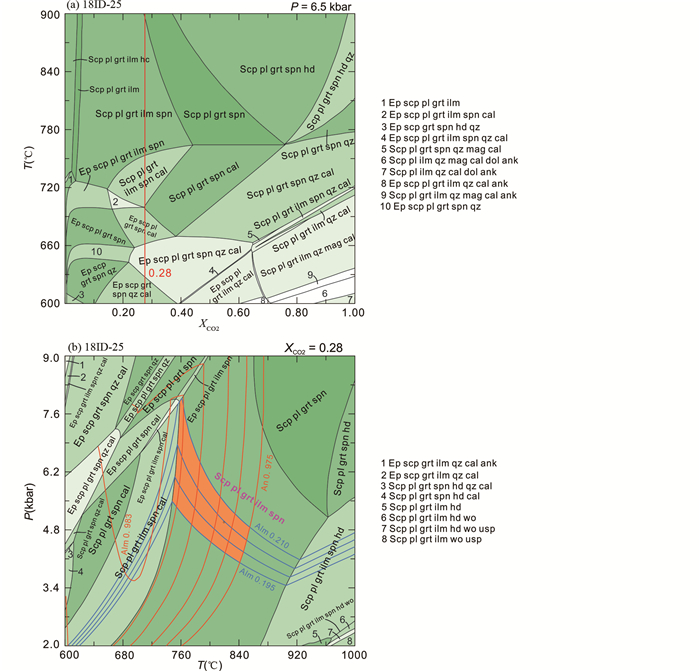
|
图 9 Tammampatti地区方柱石石榴子石钙硅酸盐岩(样品18ID-25)相平衡视剖面图 (a) NCFMASTO-CO2-H2O体系下的T-XCO2视剖面图;(b) NCFMASTO-CO2-H2O体系下的P-T视剖面图,黄色阴影区为峰期矿物组合稳定的温压范围 Fig. 9 Pesudosections calculated for calc-silicate (Sample 18ID-25) in the Tammampatti area (a) the NCFMASTO-CO2-H2O T-XCO2 pseudosection; (b) the NCFMASTO-CO2-H2O P-T pseudosection, with the P-T range of peak mineral assemblage marked by yellow shaded area |
与样品18ID-24相似,P-T视剖面图显示在模拟的温压范围内方柱石和石榴子石均稳定出现,绿帘石和石英在较低温度时出现(图 9b)。峰期矿物组合Scp+grt+pl+spn+ilm稳定的温度上限以钛铁矿的消失和钙铁辉石的出现为标志,温度下限以方解石的出现为标志,压力上限则以绿帘石的出现线为标志。此样品峰期矿物组合稳定的温压范围比较大,通过实测斜长石的钙长石成分与石榴子石的铁铝榴石成分进一步限定峰期矿物组合稳定的温压范围为750~854℃/4.0~7.8kbar(图 9b)。
6 讨论 6.1 变质时代本研究通过锆石U-Pb定年揭示Namakkal陆块Tammampatti地区方柱石石榴子石钙硅酸盐岩记录了两组变质年龄,分别为2562±17Ma(高亮度变质锆石)和2495±15Ma(低亮度变质锆石)。前人的研究显示Namakkal陆块的紫苏花岗岩、基性麻粒岩、混合岩、花岗岩、角闪岩、含石榴子石片麻岩、石榴子石辉石岩以及斜长岩记录了2530~2440Ma的变质年龄(Clark et al., 2009; Saitoh et al., 2011; Sato et al., 2011a; Anderson et al., 2012; Mohan et al., 2013; Peucat et al., 2013; Glorie et al., 2014; George et al., 2019; Peng et al., 2019)。此外,Nilgiri陆块的紫苏花岗岩、基性麻粒岩、角闪石-黑云母片麻岩与蓝晶石-石榴子石片麻岩记录有2520~2450Ma的变质年龄(Peucat et al., 2013; Samuel et al., 2014, 2015)。Biligiri Rangan陆块的紫苏花岗岩和基性麻粒岩记录有2550~2500Ma的变质年龄(Peucat et al., 2013; Ratheesh-Kumar et al., 2016, 2020)。Shevaroy陆块的紫苏花岗岩和混合岩化片麻岩则记录了2530~2500Ma的变质年龄(Peucat et al., 2013; Glorie et al., 2014)。Madras陆块的紫苏花岗岩、花岗闪长岩、长英质片麻岩、角闪岩以及条带状含铁建造记录了大约2.54~2.46Ga的变质年龄(Li et al., 2018)。不难发现上述紫苏花岗岩微陆块共同经历了大约2530~2440Ma的区域变质作用。
我们对Namakkal陆块的紫苏花岗岩年龄数据进行了统计,发现该陆块紫苏花岗岩的继承锆石年龄为2750~2600Ma,原岩结晶年龄为2580~2530Ma, 变质年龄为2520~2480Ma(表 6)。本研究高亮度变质锆石的变质年龄2562±17Ma与Peng et al. (2019)在该区域报道的紫苏花岗岩的原岩结晶年龄2559±23Ma,2577±8Ma和2562±4Ma基本一致,而较为年轻的大约2530~2500Ma的紫苏花岗岩岩浆结晶年龄(Clark et al., 2009; Saitoh et al., 2011; Glorie et al., 2014; Behera et al., 2019)可能是遭受了后期区域性高温-超高温变质作用改造的结果。因此,我们认为高亮度变质锆石记录的2562±17Ma的年龄对应于紫苏花岗原岩侵入导致的接触交代变质作用时代,而低亮度变质锆石年龄2495±15Ma与该地区普遍经历的大约2530~2440Ma的变质时代一致,应为区域性变质作用叠加的时代。
|
|
表 6 Namakkal陆块紫苏花岗岩锆石U-Pb年龄统计 Table 6 Summary of zircon U-Pb ages of the charnockites reported from the Namakkal Block |
与本研究类似的钙硅酸盐岩在印度的Eastern Ghats和Kerala孔兹岩带、斯里兰卡Maligawila地区、澳大利亚中部Arunta块体和东南极的Rauer群和Northern Prince Charles Mountains也有报道(Warren et al., 1987; Harley and Buick, 1992; Harley et al., 1994; Buick et al., 1993; Dasgupta, 1993; Fitzsimons and Harley, 1994; Bhowmik et al., 1995; Sengupta et al., 1997; Stephenson and Cook, 1997; Satish-Kumar and Harley, 1998; Mathavan and Fernando, 2001; Sengupta and Raith, 2002; Dasgupta and Pal, 2005)。
在Eastern Ghats地区,前人对发现的钙硅酸盐岩进行了大量的研究(Dasgupta, 1993; Bhowmik et al., 1995; Sengupta et al., 1997; Sengupta and Raith, 2002; Dasgupta and Pal, 2005)。例如,Dasgupta (1993)根据与方柱石-硅灰石-石榴子石钙硅酸盐岩伴生的长英质和基性麻粒岩,限定其峰期变质温压为950℃/9kbar,而Bhowmik et al. (1995)通过相平衡模拟,认为方柱石-硅灰石-石榴子石钙硅酸盐岩经历的峰期变质温压条件为975℃/9kbar。Satish-Kumar and Harley (1998)通过岩石成因格子限定了Kerala孔兹岩带的含方柱石-硅灰石-钙铝榴石的钙硅酸盐岩的峰期变质条件,为>835℃/6kbar。通过计算T-XCO2和P-XCO2岩石成因格子,Mathavan and Fernando (2001)得到斯里兰卡Maligawila地区的石榴子石-硅灰石-方柱石钙硅酸盐岩的峰期变质温压条件为900~875℃/9kbar,此外,限定峰期的流体组分为0.1 < XCO2 < 0.30。Stephenson and Cook (1997)根据实验岩石学方法得到的方柱石稳定的温度区间,推测在东南极Northern Prince Charles Mountains的Battye Glacier地区方柱石-硅灰石-石榴子石钙硅酸盐岩变质峰期≥835℃/6~7kbar;这与Fitzsimons and Thost (1992)对Porthos与Aramis地区的方柱石-石榴子石-硅灰石钙硅酸盐岩计算的温度很接近(830℃)。在Rauer Group地区,Harley et al. (1994)通过矿物反应结构,依据岩石成因格子得到含石榴子石和硅灰石的钙硅酸盐岩峰期为850~800℃/8~6kbar,CO2活度为0.35~0.45。本文通过相平衡模拟,得出峰期矿物组合方柱石+石榴子石+斜长石+榍石+钛铁矿稳定的温压条件分别为800~960℃/4.3~7.1kbar和750~854℃/4.0~7.8kbar,这与前人得到的方柱石-硅灰石-石榴子石钙硅酸盐岩峰期变质条件基本一致。
6.3 岩石成因在变质岩地体中,方柱石能够稳定在低角闪岩相(Trommsdorff, 1966; Hietanen, 1967; Groppo et al., 2017)至麻粒岩相(Abart et al., 2001; Searle and Cox, 2002)。许多学者尝试通过实验岩石学手段限定方柱石稳定的温压范围,例如Newton and Goldsmith(1975, 1976)得出纯的钙柱石稳定域超过850℃;Comodi et al. (1990)认为方柱石能够在上地幔的压力条件下稳定存在(≤18kbar),这也被Goldsmith and Newton (1977)所证实。
本研究中观察到在方柱石颗粒周围发育细小的方解石与斜长石,应为方柱石分解的产物,可能的变质反应如下:Mei=3An+Cal+Qz。在其它麻粒岩地体中也发现有类似的方柱石分解结构(Schenk, 1984; Warren et al., 1987; Motoyoshi et al., 1991; Harley and Buick, 1992; Fitzsimons and Harley, 1994; Stephenson and Cook, 1997; Satish-Kumar and Harley, 1998),其中有少量的石英作为方柱石分解产物出现(Schenk, 1984; Motoyoshi et al., 1991; Satish-Kumar and Harley, 1998),本研究观察到细小绿帘石围绕石榴子石颗粒周围生长(图 4c),指示的可能变质反应如下:An+Grt+H2O→Ep+Qz。
钙硅酸盐岩有多种成因,可以是侵入体附近的碳酸盐岩或硅酸盐岩经接触交代变质作用形成的矽卡岩,典型矿物为钙铝榴石-钙铁榴石系列的石榴子石和透辉石-钙铁辉石系列的单斜辉石,这两种主要矿物可伴生或单独出现,其次为符山石、硅灰石、方柱石、锂云母、白云母和电气石等矿物;也可以是产于孔兹岩系中的钙硅酸盐岩,由富铁白云质-钙质泥岩经变质作用形成(徐仲元等, 2005);也可以形成于陆陆碰撞的晚期,由高压基性麻粒岩在折返过程中经历退变质和Ca质交代联合作用的结果(李旭平等, 2011)。本文研究的方柱石石榴子石钙硅酸盐岩主要由钙铝榴石-钙铁榴石-铁铝榴石系列的石榴子石、钙长石质的斜长石以及钙柱石质的方柱石组成,表现出矽卡岩的矿物特征。依据前苏联学者Korzhenskii提出的矽卡岩分带理论,本研究的钙硅酸盐岩矿物组合对应于靠近侵入体一侧的内矽卡岩带,以硅酸盐矿物为主,仅有极少细粒方解石以退变质边的形式存在于方柱石颗粒边缘,因此我们更倾向于认为本次研究的钙硅酸盐岩为中酸性侵入岩(紫苏花岗岩原岩)与碳酸盐岩发生接触交代变质作用的产物。由于我们在野外并没有观察到碳酸盐岩的出露,推测碳酸盐岩的规模可能很小,以致发生接触交代反应时被消耗。
本文中方柱石石榴子石钙硅酸盐岩第一变质阶段以无水矿物组合为特征,是紫苏花岗岩的原岩侵入导致的接触交代作用的产物,第二阶段变质矿物为石榴子石周围生长的绿帘石和方柱石周围的方解石+斜长石+石英冠状体,其可能为缺流体条件下的局部退变质结果。同时该钙硅酸盐岩的组成以无水矿物为主,这可能是早期变质矿物组合得以保留下来,而没有被后期区域变质作用改造的原因。
7 结论(1) 方柱石石榴子石钙硅酸盐岩的峰期变质矿物组合为方柱石+石榴子石+斜长石+榍石+钛铁矿,对应的变质温压条件为800~960℃/4.3~7.1kbar和750~854℃/4.0~7.8kbar。
(2) LA-ICP-MS锆石U-Pb测年获得2个207Pb/206Pb加权平均年龄:2562±17Ma和2495±15Ma,分别对应于紫苏花岗岩原岩侵入造成的接触交代作用时代和区域变质作用叠加的时代。
(3) Tammampatti地区的方柱石石榴子石钙硅酸盐岩为中酸性侵入岩(紫苏花岗岩原岩)与碳酸盐岩发生接触交代变质作用的产物。
致谢 感谢印度科学研究院地球科学中心K. Sajeev博士和西北大学胡育华同学在野外工作中的帮助!感谢两位匿名审稿人的宝贵意见与建议;感谢编辑部老师在文章修改、校对过程中的指导与帮助。
Abart R, Schmid R and Harlov D. 2001. Metasomatic coronas around hornblendite xenoliths in granulite facies marble, Ivrea zone, N Italy, I: Constraints on component mobility. Contributions to Mineralogy and Petrology, 141(4): 473-493 DOI:10.1007/s004100100255
|
Anderson JR, Payne JL, Kelsey DE, Hand M, Collins AS and Santosh M. 2012. High-pressure granulites at the dawn of the Proterozoic. Geology, 40(5): 431-434 DOI:10.1130/G32854.1
|
Behera BM, Waele BD, Thirukumaran V, Sundaralingam K, Narayanan S, Sivalingam B and Biswal TK. 2019. Kinematics, strain pattern and geochronology of the salem-attur shear zone: Tectonic implications for the multiple sheared Salem-Namakkal blocks of the Southern Granulite Terrane, India. Precambrian Research, 324: 32-61 DOI:10.1016/j.precamres.2019.01.022
|
Bernard-Griffiths J, Jahn BM and Sen SK. 1987. Sm-Nd isotopes and REE geochemistry of Madras granulites, India: An introductory statement. Precambrian Research, 37(4): 343-355 DOI:10.1016/0301-9268(87)90082-9
|
Bhowmik SK, Dasgupta S, Hoernes S and Bhattacharya PK. 1995. Extremely high-temperature calcareous granulites from the Eastern Ghats, India: Evidence for isobaric cooling, fluid buffering, and terminal channelized fluid flow. European Journal of Mineralogy, 7(3): 689-704 DOI:10.1127/ejm/7/3/0689
|
Brandt S, Raith MM, Schenk V, Sengupta P, Srikantappa C and Gerdes A. 2014. Crustal evolution of the Southern Granulite Terrane, South India: New geochronological and geochemical data for felsic orthogneisses and granites. Precambrian Research, 246: 91-122 DOI:10.1016/j.precamres.2014.01.007
|
Buick IS, Harley SL and Cartwright IC. 1993. Granulite facies metasomatism: Zoned calc-silicate boudins from the Rauer Group, East Antarctica. Contributions to Mineralogy and Petrology, 113(4): 557-571 DOI:10.1007/BF00698323
|
Chadwick B, Vasudev VN and Hedge GV. 2000. The Dharwar craton, Southern India, interpreted as the result of Late Archaean oblique convergence. Precambrian Research, 99(1-2): 91-101 DOI:10.1016/S0301-9268(99)00055-8
|
Chardon D, Jayananda M and Peucat JJ. 2011. Lateral constrictional flow of hot orogenic crust: Insights from the Neoarchean of South India, geological and geophysical implications for orogenic plateaux. Geochemistry, Geophysics, Geosystems, 12(2): Q02005
|
Clark C, Collins AS, Timms NE, Kinny PD, Chetty TRK and Santosh M. 2009. SHRIMP U-Pb age constraints on magmatism and high-grade metamorphism in the Salem Block, southern India. Gondwana Research, 16(1): 27-36 DOI:10.1016/j.gr.2008.11.001
|
Collins AS, Clark C, Sajeev K, Santosh M, Kelsey DE and Hand M. 2007. Passage through India: The Mozambique Ocean suture, high-pressure granulites and the Palghat-Cauvery Shear zone system. Terra Nova, 19(2): 141-147 DOI:10.1111/j.1365-3121.2007.00729.x
|
Comodi P, Mellini M and Zanazzi PF. 1990. Scapolites: Variation of structure with pressure and possible role in the storage of fluids. European Journal of Mineralogy, 2(2): 195-202 DOI:10.1127/ejm/2/2/0195
|
Connolly JAD. 1990. Multivariable phase diagrams: An algorithm based on generalized thermodynamics. American Journal of Science, 290: 666-718 DOI:10.2475/ajs.290.6.666
|
Connolly JAD. 2005. Computation of phase equilibria by linear programming: A tool for geodynamic modeling and its application to subduction zone decarbonation. Earth and Planetary Science Letters, 236(1-2): 524-541 DOI:10.1016/j.epsl.2005.04.033
|
Crawford AR. 1969. India, Ceylon and Pakistan: New age data and comparisons with Australia. Nature, 223(5204): 380-384 DOI:10.1038/223380a0
|
Dasgupta S. 1993. Contrasting mineral parageneses in high-temperature calc-silicate granulites: Examples from the Eastern Ghats, India. Journal of Metamorphic Geology, 11(2): 193-202 DOI:10.1111/j.1525-1314.1993.tb00142.x
|
Dasgupta S and Pal S. 2005. Origin of grandite garnet in calc-silicate granulites: Mineral-fluid equilibria and petrogenetic grids. Journal of Petrology, 46(5): 1045-1076 DOI:10.1093/petrology/egi010
|
Deer WA, Howie RA and Zussman J. 2013. An Introduction to the Rock-Forming Minerals. 3rd Edition. London: United Kingdom: Mineralogical Society of Great Britain and Ireland, 349-353
|
Fitzsimons ICW and Thost DE. 1992. Geological relationships in high-grade basement gneiss of the Northern Prince Charles Mountains, East Antarctica. Australian Journal of Earth Sciences, 39(2): 173-193 DOI:10.1080/08120099208728013
|
Fitzsimons ICW and Harley SL. 1994. Garnet coronas in scapolite-wollastonite calc-silicates from East Antarctica: The application and limitations of activity-corrected grids. Journal of Metamorphic Geology, 12(6): 761-777 DOI:10.1111/j.1525-1314.1994.tb00058.x
|
Friend CRL and Nutman AP. 1991. SHRIMP U-Pb geochronology of the Closepet Granite and Peninsular Gneiss, Karnataka, South India. Journal of the Geological Society of India, 38(4): 357-368
|
George PM and Sajeev K. 2015. Crustal evolution of Kolli-Massif, Southern India. Journal of the Indian Institute of Science, 95(2): 187-202
|
George PM, Sajeev K, Santosh M and Zhai MG. 2019. Granulite-grade garnet pyroxenite from the Kolli-massif, Southern India: Implications for Archean crustal evolution. Lithos, 342-343: 499-512 DOI:10.1016/j.lithos.2019.05.040
|
Glorie S, De Grave J, Singh T, Payne JL and Collins AS. 2014. Crustal root of the Eastern Dharwar Craton: Zircon U-Pb age and Lu-Hf isotopic evolution of the East Salem Block, Southeast India. Precambrian Research, 249: 229-246 DOI:10.1016/j.precamres.2014.05.017
|
Goldsmith JR. 1976. Scapolites, granulites, and volatiles in the lower crust. Geological Society of America Bulletin, 87(2): 161-168 DOI:10.1130/0016-7606(1976)87<161:SGAVIT>2.0.CO;2
|
Goldsmith JR and Newton RC. 1977. Scapolite-plagioclase stability relations at high pressures and temperatures in the system NaAlSi3O8-CaAl2Si2O8-CaCO3-CaSO4. American Mineralogist, 62(11-12): 1063-1081
|
Groppo C, Rolfo F, Castelli D and Connolly JAD. 2013. Metamorphic CO2 production from calc-silicate rocks via garnet-forming reactions in the CFAS-H2O-CO2 system. Contributions to Mineralogy and Petrology, 166(6): 1655-1675 DOI:10.1007/s00410-013-0947-5
|
Groppo C, Rolfo F, Castelli D and Mosca P. 2017. Metamorphic CO2 production in collisional orogens: Petrological constraints from phase diagram modeling of Himalayan, scapolite-bearing, calc-silicate rocks in the NKC(F)MAS(T)-HC system. Journal of Petrology, 58(1): 53-83 DOI:10.1093/petrology/egx005
|
Guo S, Chen Y, Liu CZ, Wang JG, Su B, Gao YJ, Wu FY, Sein K, Yang YH and Mao Q. 2016. Scheelite and coexisting F-rich zoned garnet, vesuvianite, fluorite, and apatite in calc-silicate rocks from the Mogok metamorphic belt, Myanmar: Implications for metasomatism in marble and the role of halogens in W mobilization and mineralization. Journal of Asian Earth Sciences, 117: 82-106 DOI:10.1016/j.jseaes.2015.12.004
|
Harley SL and Buick IS. 1992. Wollastonite-scapolite assemblages as indicators of granulite pressure-temperature-fluid Histories: The Rauer Group, East Antarctica. Journal of Petrology, 33(3): 693-728 DOI:10.1093/petrology/33.3.693
|
Harley SL, Fitzsimons ICW and Buick IS. 1994. Reactions and textures in wollastonite-scapolite granulites and their significance for pressure-temperature-fluid histories of high-grade terranes. Precambrian Research, 66(1-4): 309-323 DOI:10.1016/0301-9268(94)90056-6
|
He HL, Wang YQ, Bao ZA, George PM, Veni S, Sajeev K, Guo JH, Zhai MG and Lai KC. 2020. Role of melt injection and mixing in the formation of chromitite in Archean megacrystic anorthosites: Evidence from the Sittampundi anorthosite complex, southern India. Precambrian Research, 350: 105914 DOI:10.1016/j.precamres.2020.105914
|
He HL, Wang YQ, George PM, Sajeev K, Guo JH, Lai KC and Zhai MG. 2021. Formation of ~2.5Ga Sittampundi anorthosite complex in southern India: Implications to lower crustal stabilization of the Dharwar Craton. Precambrian Research, 354: 106012
|
Hietanen A. 1967. Scapolite in the Belt Series in the St. Joe-Clearwater Region, Idaho. Geological Society of America Special Papers, 86: 1-54
|
Hokada T, Horie K, Satish-Kumar M, Ueno Y, Nasheeth A, Mishima K and Shiraishi K. 2013. An appraisal of Archaean supracrustal sequences in Chitradurga schist belt, Western Dharwar Craton, Southern India. Precambrian Research, 227: 99-119 DOI:10.1016/j.precamres.2012.04.006
|
Holland TJB and Powell R. 1998. An internally consistent thermodynamic data set for phases of petrological interest. Journal of Metamorphic Geology, 16(3): 309-343
|
Holland TJB and Powell R. 2011. An improved and extended internally consistent thermodynamic dataset for phases of petrological interest, involving a new equation of state for solids. Journal of Metamorphic Geology, 29(3): 333-383 DOI:10.1111/j.1525-1314.2010.00923.x
|
Ishwar-Kumar C, Windley BF, Horie K, Kato T, Hokada T, Itaya T, Yagi K, Gouzu C and Sajeev K. 2013. A Rodinian suture in western India: New insights on India-Madagascar correlations. Precambrian Research, 236(1379): 227-251
|
Jayananda M, Martin H, Peucat JJ and Mahabaleswar B. 1995. Late Archaean crust-mantle interactions: Geochemistry of LREE-enriched mantle derived magmas. Example of the Closepet batholith, southern India. Contributions to Mineralogy and Petrology, 119(2): 314-329 DOI:10.1007/s004100050045
|
Jayananda M, Moyen JF, Martin H, Peucat JJ, Auvray B and Mahabaleswar B. 2000. Late Archaean (2550~2520Ma) juvenile magmatism in the Eastern Dharwar craton, southern India: Constraints from geochronology, Nd-Sr isotopes and whole rock geochemistry. Precambrian Research, 99(3-4): 225-254 DOI:10.1016/S0301-9268(99)00063-7
|
Jayananda M, Chardon D, Peucat JJ and Capdevila R. 2006. 2.61Ga potassic granites and crustal reworking in the western Dharwar craton, southern India: Tectonic, geochronologic and geochemical constraints. Precambrian Research, 150(1-2): 1-26
|
Jayananda M, Kano T, Peucat JJ and Channabasappa S. 2008. 3.35Ga komatiite volcanism in the western Dharwar Craton, Southern India: Constraints from Nd isotopes and whole-rock geochemistry. Precambrian Research, 162(1-2): 160-179
|
Jayananda M, Tsutsumi Y, Miyazaki T, Gireesh RV, Kapfo K, Hadaka H and Kano T. 2013a. Geochronological constraints on Meso- and Neoarchean regional metamorphism and magmatism in the Dharwar craton, southern India. Journal of Asian Earth Sciences, 78(3): 18-38
|
Jayananda M, Peucat JJ, Chardon D, Krishna Rao B, Fanning CM and Corfu F. 2013b. Neoarchean greenstone volcanism and continental growth, Dharwar craton, Southern India: Constraints from SIMS U-Pb zircon geochronology and Nd isotopes. Precambrian Research, 227: 55-76 DOI:10.1016/j.precamres.2012.05.002
|
Jayananda M, Santosh M and Aadhiseshan KR. 2018. Formation of Archean (3600~2500Ma) continental crust in the Dharwar Craton, southern India. Earth-Science Reviews, 181: 12-42 DOI:10.1016/j.earscirev.2018.03.013
|
Kuhn BK. 2004. Scapolite stability: Phase relations and chemistry of impure metacarbonate rocks in the Central Alps. Doctor Degree Thesis. Zürich: Swiss Federal Institute of Technology
|
Kullerud K and Erambert M. 1999. Cl-scapolite, Cl-amphibole, and plagioclase equilibria in ductile shear zones at Nusfjord, Lofoten, Norway: Implications for fluid compositional evolution during fluid-mineral interaction in the deep crust. Geochimica et Cosmochimica Acta, 63(22): 3829-3844 DOI:10.1016/S0016-7037(99)00150-7
|
Lancaster PJ, Dey S, Storey CD, Mitra A and Bhunia RK. 2015. Contrasting crustal evolution processes in the Dharwar Craton: Insights from detrital zircon U-Pb and Hf isotopes. Gondwana Research, 28(4): 1361-1372 DOI:10.1016/j.gr.2014.10.010
|
Li XP, Guo JH, Zhao GC, Li HK and Song ZJ. 2011. Formation of the Paleoproterozoic calc-silicate and high-pressure mafic granulite in the Jiaobei terrane, eastern Shandong, China. Acta Petrologica Sinica, 27(4): 961-968 (in Chinese with English abstract)
|
Li SS, Santosh M, Ganguly S, Thanooja PV, Sajeev K, Pahari A and Manikyamba C. 2018. Neoarchean microblock amalgamation in southern India: Evidence from the Nallamalai Suture Zone. Precambrian Research, 314: 1-27 DOI:10.1016/j.precamres.2018.05.017
|
Markl G and Piazolo S. 1998. Halogen-bearing minerals in syenites and high-grade marbles of Dronning Maud Land, Antarctica: Monitors of fluid compositional changes during late-magmatic fluid-rock interaction processes. Contributions to Mineralogy and Petrology, 132(3): 246-268 DOI:10.1007/s004100050420
|
Mathavan V and Fernando GWAR. 2001. Reactions and textures in grossular-wollastonite-scapolite calc-silicate granulites from Maligawila, Sri Lanka: Evidence for high-temperature isobaric cooling in the meta-sediments of the Highland Complex. Lithos, 59(4): 217-232 DOI:10.1016/S0024-4937(01)00057-3
|
Moecher DP, Valley JW and Essene EJ. 1994. Extraction and carbon isotope analysis of CO2 from scapolite in deep crustal granulites and xenoliths. Geochimica et Cosmochimica Acta, 58(2): 959-967 DOI:10.1016/0016-7037(94)90518-5
|
Mohan MR, Satyanarayanan M, Santosh M, Sylvester PJ, Tubrett M and Lam R. 2013. Neoarchean suprasubduction zone arc magmatism in southern India: Geochemistry, zircon U-Pb geochronology and Hf isotopes of the Sittampundi Anorthosite Complex. Gondwana Research, 23(2): 539-557 DOI:10.1016/j.gr.2012.04.004
|
Mora CI and Valley JW. 1989. Halogen-rich scapolite and biotite: Implications for metamorphic fluid-rock interaction. American Mineralogist, 74: 721-737
|
Motoyoshi Y, Thost DE and Hensen BJ. 1991. Reaction textures in calc-silicate granulites from the Bolingen Islands, Prydz Bay, East Antarctica: Implications for the retrograde P-T path. Journal of Metamorphic Geology, 9(3): 293-300 DOI:10.1111/j.1525-1314.1991.tb00524.x
|
Moyen JF, Nédélec A, Martin H and Jayananda M. 2003. Syntectonic granite emplacement at different structural levels: The Closepet granite, South India. Journal of Structural Geology, 25(4): 611-631 DOI:10.1016/S0191-8141(02)00046-9
|
Newton RC and Goldsmith JR. 1975. Stability of the scapolite meionite (3CaAl2Si2O2·CaCO3) at high pressures and storage of CO2 in the deep crust. Contributions to Mineralogy and Petrology, 49: 49-62 DOI:10.1007/BF00371078
|
Newton RC and Goldsmith JR. 1976. Stability of the end-member scapolites: 3NaAlSi3O8·NaCl, 3CaAl2Si2O8·CaCO3, 3CaAl2Si2O8·CaSO4. Zeitschrift für Kristallographie, 143(1-6): 333-353
|
Newton RC, Charlu TV and Kleppa OJ. 1980. Thermochemistry of the high structural state plagioclases. Geochimica et Cosmochimica Acta, 44(7): 933-941 DOI:10.1016/0016-7037(80)90283-5
|
Nishimiya Y, Tsunogae T and Santosh M. 2010. Sapphirine+quartz corona around magnesian (XMg~0.58) staurolite from the Palghat-Cauvery Suture Zone, Southern India: Evidence for high-pressure and ultrahigh-temperature metamorphism within the Gondwana suture. Lithos, 114(3-4): 490-502
|
Noack NM, Kleinschrodt R, Kirchenbaur M, Fonseca ROC and Münker C. 2013. Lu-Hf isotope evidence for Paleoproterozoic metamorphism and deformation of Archean oceanic crust along the Dharwar Craton margin, southern India. Precambrian Research, 233(5): 206-222
|
Nutman AP, Chadwick B, Krishna RB and Vasudev VN. 1996. SHRIMP U/Pb zircon ages of acid volcanic rocks in the Chitradurga and Sandur groups, and granites adjacent to the Sandur schist belt, Karnataka. Journal of the Geological Society of India, 47(2): 153-164
|
Oliver NHS, Rawling TJ, Cartwright I and Pearson PJ. 1994. High-temperature fluid-rock interaction and scapolitization in an extension-related hydrothermal system, Mary Kathleen, Australia. Journal of Petrology, 35(6): 1455-1493 DOI:10.1093/petrology/35.6.1455
|
Peng P, Qin ZY, Sun FB, Zhou XT, Guo JH, Zhai MG and Ernst RE. 2019. Nature of charnockite and Closepet granite in the Dharwar Craton: Implications for the architecture of the Archean crust. Precambrian Research, 334: 105478 DOI:10.1016/j.precamres.2019.105478
|
Peucat JJ, Bouhallier H, Fanning CM and Jayananda M. 1995. Age of the Holenarsipur greenstone belt, relationships with the surrounding gneisses (Karnataka, South India). Journal of Geology, 103(6): 701-710 DOI:10.1086/629789
|
Peucat JJ, Jayananda M, Chardon D, Capdevila R, Fanning CM and Paquette JL. 2013. The lower crust of the Dharwar Craton, Southern India: Patchwork of Archean granulitic domains. Precambrian Research, 227: 4-28 DOI:10.1016/j.precamres.2012.06.009
|
Plavsa D, Collins AS, Foden JF, Kropinski L, Santosh M, Chetty TRK and Clark C. 2012. Delineating crustal domains in Peninsular India: Age and chemistry of orthopyroxene-bearing felsic gneisses in the Madurai Block. Precambrian Research, 198-199: 77-93 DOI:10.1016/j.precamres.2011.12.013
|
Plavsa D, Collins AS, Foden JD and Clark C. 2015. The evolution of a Gondwanan collisional orogen: A structural and geochronological appraisal from the Southern Granulite Terrane, South India. Tectonics, 34(5): 820-857 DOI:10.1002/2014TC003706
|
Raith MM, Srikantappa C, Buhl D and Koehler H. 1999. The Nilgiri enderbites, South India: Nature and age constraints on protolith formation, high-grade metamorphism and cooling history. Precambrian Research, 98(1-2): 129-150 DOI:10.1016/S0301-9268(99)00045-5
|
Ratheesh-Kumar RT, Santosh M, Yang QY, Ishwar-Kumar C, Chen NS and Sajeev K. 2016. Archean tectonics and crustal evolution of the Biligiri Rangan Block, southern India. Precambrian Research, 275: 406-428 DOI:10.1016/j.precamres.2016.01.022
|
Ratheesh-Kumar RT, Windley BF, Xiao WJ, Jia XL, Mohanty DP and Zeba-Nezrin FK. 2020. Early growth of the Indian lithosphere: Implications from the assembly of the Dharwar Craton and adjacent granulite blocks, southern India. Precambrian Research, 336: 105491 DOI:10.1016/j.precamres.2019.105491
|
Rebbert CR and Rice JM. 1997. Scapolite-plagioclase exchange: Cl-CO3 scapolite solution chemistry and implications for peristerite plagioclase. Geochimica et Cosmochimica Acta, 61(3): 555-567 DOI:10.1016/S0016-7037(96)00362-6
|
Saitoh Y, Tsunogae T, Santosh M, Chetty TRK and Horie K. 2011. Neoarchean high-pressure metamorphism from the northern margin of the Palghat-Cauvery Suture Zone, southern India: Petrology and zircon SHRIMP geochronology. Journal of Asian Earth Sciences, 42(3): 268-285 DOI:10.1016/j.jseaes.2010.11.015
|
Sajeev K, Windley BF, Connolly JAD and Kon Y. 2009. Retrogressed eclogite (20kbar, 1020℃) from the Neoproterozoic Palghat-Cauvery suture zone, southern India. Precambrian Research, 171(1-4): 23-36 DOI:10.1016/j.precamres.2009.03.001
|
Samuel VO, Santosh M, Liu SW, Wang W and Sajeev K. 2014. Neoarchean continental growth through arc magmatism in the Nilgiri Block, southern India. Precambrian Research, 245: 146-173 DOI:10.1016/j.precamres.2014.02.002
|
Samuel VO, Sajeev K, Hokada T, Horie K and Itaya T. 2015. Neoarchean arc magmatism followed by high-temperature, high-pressure metamorphism in the Nilgiri Block, southern India. Tectonophysics, 662: 109-124 DOI:10.1016/j.tecto.2015.06.035
|
Samuel VO, Santosh M, Yang QY and Sajeev K. 2016. Geochemistry and zircon geochronology of the Neoarchean volcano-sedimentary sequence along the northern margin of the Nilgiri block, southern India. Lithos, 263: 257-273 DOI:10.1016/j.lithos.2016.01.027
|
Samuel VO, Kwon S, Santosh M and Sajeev K. 2018. Garnet pyroxenite from Nilgiri Block, southern India: Vestiges of a Neoarchean volcanic arc. Lithos, 310-311: 120-135 DOI:10.1016/j.lithos.2018.04.009
|
Santosh M, Tsunogae T and Koshimoto S. 2004. First report of sapphirine-bearing rocks from the Palghat-Cauvery shear zone system, Southern India. Gondwana Research, 7(2): 620-626 DOI:10.1016/S1342-937X(05)70813-3
|
Santosh M, Collins AS, Tamashiro I, Koshimoto S, Tsutsumi Y and Yokoyama K. 2006. The timing of ultrahigh-temperature metamorphism in Southern India: U-Th-Pb electron microprobe ages from zircon and monazite in sapphirine-bearing granulites. Gondwana Research, 10(1-2): 128-155 DOI:10.1016/j.gr.2005.12.005
|
Santosh M, Maruyama S and Sato K. 2009. Anatomy of a Cambrian suture in Gondwana: Pacific type orogeny in southern India. Gondwana Research, 16: 321-341 DOI:10.1016/j.gr.2008.12.012
|
Santosh M, Xiao WJ, Tsunogae T, Chetty TRK and Yellappa T. 2012. The Neoproterozoic subduction complex in southern India: SIMS zircon U-Pb ages and implications for Gondwana assembly. Precambrian Research, 192-195: 190-208 DOI:10.1016/j.precamres.2011.10.025
|
Santosh M, Yang QY, Mohan MR, Tsunogae T, Shaji E and Satyanarayanan M. 2014. Cryogenian alkaline magmatism in the Southern Granulite Terrane, India: Petrology, geochemistry, zircon U-Pb ages and Lu-Hf isotopes. Lithos, 208-209: 430-445 DOI:10.1016/j.lithos.2014.09.016
|
Santosh M, Yang QY, Shaji E, Tsunogae T, Mohan MR and Satyanarayanan M. 2015. An exotic Mesoarchean microcontinent: The Coorg Block, southern India. Gondwana Research, 27: 165-195 DOI:10.1016/j.gr.2013.10.005
|
Satish-Kumar M, Santosh M, Harley SL and Yoshida M. 1996. Calc-silicate assemblages from the Kerala Khondalite Belt, southern India: Implications for pressure-temperature-fluid histories. Journal of Southeast Asian Earth Sciences, 14(3-4): 245-263 DOI:10.1016/S0743-9547(96)00062-1
|
Satish-Kumar M and Harley SL. 1998. Reaction textures in scapolite-wollastonite-grossular calc-silicate rock from the Kerala Khondalite Belt, Southern India: Evidence for high-temperature metamorphism and initial cooling. Lithos, 44(3-4): 83-99 DOI:10.1016/S0024-4937(98)00017-6
|
Satish-Kumar M, Hermann J, Tsunogae T and Osanai Y. 2006. Carbonation of Cl-rich scapolite boudins in Skallen, East Antarctica: Evidence for changing fluid condition in the continental crust. Journal of Metamorphic Geology, 24(3): 241-261 DOI:10.1111/j.1525-1314.2006.00635.x
|
Sato K, Santosh M, Tsunogae T, Chetty TRK and Hirata T. 2011a. Laser ablation ICP mass spectrometry for zircon U-Pb geochronology of metamorphosed granite from the Salem Block: Implication for Neoarchean crustal evolution in southern India. Journal of Mineralogical and Petrological Sciences, 106(1): 1-12 DOI:10.2465/jmps.091222
|
Sato K, Santosh M, Tsunogae T, Chetty TRK and Hirata T. 2011b. Subduction-accretion-collision history along the Gondwana suture in southern India: A laser ablation ICP-MS study of zircon chronology. Journal of Asian Earth Sciences, 40(1): 162-171 DOI:10.1016/j.jseaes.2010.08.008
|
Schenk V. 1984. Petrology of felsic granulites, metapelites, metabasics, ultramafics, and metacarbonates from southern Calabria (Italy): Prograde metamorphism, uplift and cooling of a former lower crust. Journal of Petrology, 25: 255-298 DOI:10.1093/petrology/25.1.255
|
Searle MP and Cox J. 2002. Subduction zone metamorphism during formation and emplacement of the Semail ophiolite in the Oman Mountains. Geological Magazine, 139(3): 241-255 DOI:10.1017/S0016756802006532
|
Sengupta P, Sanyal S, Dasgupta S, Fukuoka M and Ehl J. 1997. Controls of mineral reactions in high-grade garnet-wollastonite-scapolite-bearing calcsilicate rocks: An example from Anakapalle, Eastern Ghats, India. Journal of Metamorphic Geology, 15(5): 551-564 DOI:10.1111/j.1525-1314.1997.tb00635.x
|
Sengupta P and Raith MM. 2002. Garnet composition as a petrogenetic indicator: An example from a marble-calc-silicate granulite interface at Kondapalle, Eastern Ghats Belt, India. American Journal of Science, 302(8): 686-725 DOI:10.2475/ajs.302.8.686
|
Shimpo M, Tsunogae T and Santosh M. 2006. First report of garnet-corundum rocks from southern India: Implications for prograde high-pressure (eclogite-facies?) metamorphism. Earth and Planetary Science Letters, 242(1-2): 111-129 DOI:10.1016/j.epsl.2005.11.042
|
Stephenson NCN and Cook NDJ. 1997. Metamorphic evolution of calcsilicate granulites near Battye Glacier, northern Prince Charles Mountains, East Antarctica. Journal of Metamorphic Geology, 15(3): 361-378 DOI:10.1111/j.1525-1314.1997.00024.x
|
Sun SS and McDonough WF. 1989. Chemical and isotopic systematics of oceanic basalts: Implications for mantle composition and processes. In: Saunders AD and Norry MJ (eds.). Magmatism in the Ocean Basins. Geological Society, London, Special Publications, 42(1): 313-345 DOI:10.1144/GSL.SP.1989.042.01.19
|
Talukdar M, Mukhopadhyay D, Sanyal S and Sengupta P. 2020. Early Palaeoproterozoic structural reconstitution of a suite of rocks from the Mahadevi Layered Complex, Tamil Nadu, India. Geological Journal, 55(2): 3615-3642
|
Teertstra DK and Sherriff BL. 1997. Substitutional mechanisms, compositional trends and the end-member formulae of scapolite. Chemical Geology, 136(3-4): 233-260 DOI:10.1016/S0009-2541(96)00146-5
|
Thu YK and Enami M. 2018. Evolution of metamorphic fluid recorded in granulite facies metacarbonate rocks from the middle segment of the mogok metamorphic belt in central myanmar. Journal of Metamorphic Geology, 36(7): 905-931 DOI:10.1111/jmg.12419
|
Trendall AF, De Laeter JR, Nelson DR and Mukhopadhyay D. 1997a. A precise zircon U-Pb age for the base of the BIF of the Mulaingiri formation, (Bababudan Group, Dharwar Supergroup) of the Karnataka craton. Journal of the Geological Society of India, 50(2): 161-170
|
Trendall AF, De Laeter JR, Nelson DR and Bhaskar Rao YJ. 1997b. Further zircon U-Pb age data for the Daginkatte formation, Dharwar Supergroup, Karnataka craton. Journal of the Geological Society of India, 50(1): 25-30
|
Trommsdorff V. 1966. Progressive Metamorphose kieseliger Karbonatgesteine in den Zentralalpen zwischen Bernina und Simplon. Schweizerische Mineralogische und Petrographische Mitteilungen, 46: 431-460
|
Wang JY and Santosh M. 2019. Eoarchean to Mesoarchean crustal evolution in the Dharwar craton, India: Evidence from detrital zircon U-Pb and Hf isotopes. Gondwana Research, 72: 1-14 DOI:10.1016/j.gr.2019.02.006
|
Warren RG, Hensen BJ and Ryburn RJ. 1987. Wollastonite and scapolite in Precambrian calc-silicate granulites from Australia and Antarctica. Journal of Metamorphic Geology, 5(2): 213-223 DOI:10.1111/j.1525-1314.1987.tb00380.x
|
White RW, Powell R, Holland TJB and Worley BA. 2000. The effect of TiO2 and Fe2O3 on metapelitic assemblages at greenschist and amphibolite facies conditions: Mineral equilibria calculations in the system K2O-FeO-MgO-Al2O3-SiO2-H2O-TiO2-Fe2O3. Journal of Metamorphic Geology, 18(5): 497-511 DOI:10.1046/j.1525-1314.2000.00269.x
|
Whitney DL and Evans BW. 2010. Abbreviations for names of rock-forming minerals. American Mineralogist, 95(1): 185-187 DOI:10.2138/am.2010.3371
|
Xu ZY, Liu ZH, Hu FX and Yang ZS. 2005. Geochemical characteristics of the calc-silicate rocks in Khondalite Series in Daqingshan area, Inner Mongolia. Journal of Jilin University (Earth Science Edition), 35(6): 681-689 (in Chinese with English abstract)
|
Yellappa T, Santosh M, Chetty TRK, Kwon S, Park C, Nagesh P, Mohanty DP and Venkatasivappa V. 2012. A Neoarchean dismembered ophiolite complex from southern India: Geochemical and geochronological constraints on its suprasubduction origin. Gondwana Research, 21: 246-265 DOI:10.1016/j.gr.2011.05.003
|
李旭平, 郭敬辉, 赵国春, 李洪奎, 宋召军. 2011. 胶北地块早元古代钙硅酸盐岩与高压基性麻粒岩成因及地质意义. 岩石学报, 27(4): 961-968. |
徐仲元, 刘正宏, 胡风翔, 杨振升. 2005. 内蒙古大青山地区孔兹岩系中钙硅酸盐岩的组成和地球化学特征. 吉林大学学报(地球科学版), 35(6): 681-689. |
 2021, Vol. 37
2021, Vol. 37


